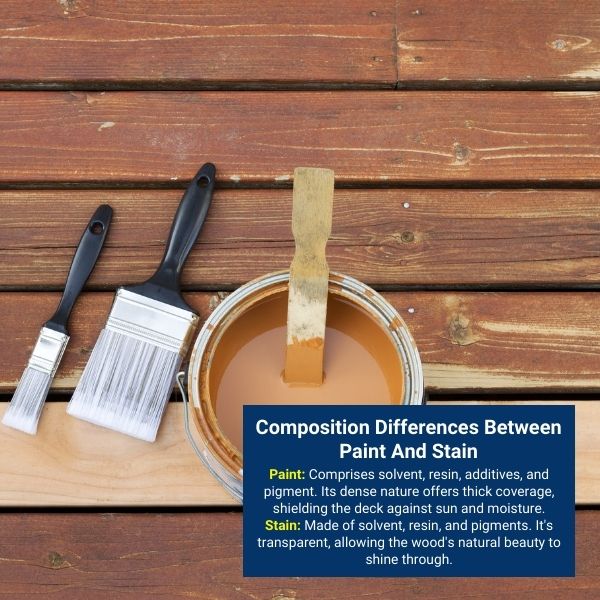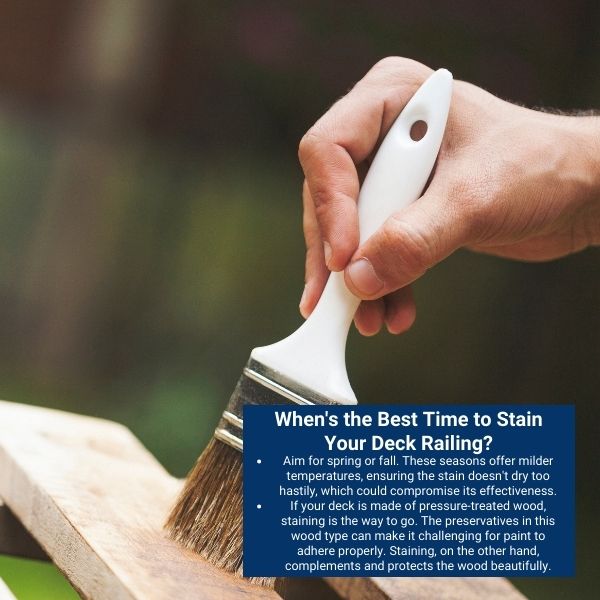You’ve all been there. You step outside, coffee in hand, ready to enjoy a peaceful morning on your deck. But instead of relaxation, your eyes are drawn to the worn-out railing. The once vibrant color has faded, and you’re left wondering: should I paint or stain it?
Staining a deck railing highlights the wood’s beauty, lasts 1-3 years, and costs $20-$50/gallon with easy upkeep. Painting offers a 10+ year lifespan, diverse colors, and robust UV/weather protection at $40-$80/gallon. While the stain is less slippery and quicker to apply, paint provides a smoother, durable finish.
But wait, there’s more!
This guide will outline the pros, cons, and intricate details of both options. I’ll discuss how they differ and the best times to apply either paint or stain, as well as their correct application processes.
With all this info, you’ll be set to pick what makes your deck look awesome and last a long time. So, Let’s dive in!
Deck Paint Or Stain: Which One’s Right For You?
Choosing between paint and stain is not just about how it looks, but also how much work you want to put in later.
So, Let’s look at the good and bad sides of both, so you can decide like I did when I built a cedar deck railing and thought about painting it.
But my buddy said, “Why not stain it to show off the wood?” I paused, gathered all the information, and put my expertise to work.

Painting: A Complete Transformation
A good quality paint, especially the water-based types, can adapt to the wood’s natural moisture changes. Paint forms a thick layer on the wood, hiding any flaws and protecting it from moisture and sunlight. Here’s the breakdown:
- Full Coverage: Paint provides a dense layer, effectively covering any imperfections or old blemishes on your deck.
- Variety: With paint, the color possibilities are endless, allowing you to perfectly match or contrast with your home’s exterior.
- Longevity: A significant advantage of paint is its durability. With proper care, a painted deck can remain vibrant for a decade or more.
- Maintenance: Painted decks are low-maintenance. Simple cleaning with water and soap keeps them looking fresh.
- Cost: Painting might come with a heftier price tag initially, but considering its longevity, it can be a sound long-term investment.
But, painting isn’t a walk in the park. It can get messy, and you’ll need to get the wood ready first. And if you’re not great with a paintbrush, it might not look as neat as you’d like.
Note: For high traffic areas, a stain that repels water might be better.
Staining: Celebrating The Wood’s Essence
Staining, on the other hand, won’t last as long as paint. While it seeps into the wood and protects it from moisture, it’s not as effective as the protective layer paint offers.
The good news? Most stains come with wood preservatives, so you won’t have to worry about mold or rot.
But, they don’t shield the wood from sunlight as effectively. If your railing is in a sunny spot, it might start to fade after a few years.
However, there are solid-color stains that can offer a middle ground. They protect the wood like paint but are thinner, so the wood’s texture still shows. They come in various shades, and a good one might last you up to eight years.
One more thing to consider: many folks find staining easier than painting. So, even if you have to redo it more often, each time might be less of a hassle.
Staining is all about showcasing the inherent beauty of your deck’s wood. Here’s a closer look:
- Natural Appeal: Stains penetrate the wood, emphasizing its grain and texture. If you’re a fan of the wood’s authentic charm, staining is your best bet.
- Cost-Effective: Staining is generally more wallet-friendly, making it an attractive option for those looking to refresh their deck on a budget.
- Simple Application: A single coat of stain can do the trick, leaving no brush or roller marks behind.
- Maintenance: While stains offer protection against the sun, they might need reapplication every 1-2 years, especially if your deck faces harsh weather elements.
- Weather Damage: Stains might not effectively cover old damages or those inflicted by the elements.
Pros And Cons: Painting Your Deck Railing
Advantages of Deck Paint:
- Deck paint offers a vast selection of colors, ensuring there’s something for everyone.
- Once applied, it demands minimal upkeep and can last up to 10 years.
- Its thick consistency is perfect for covering any imperfections, even on deck railings.
- Painted decks, including deck railings, generally have a longer lifespan.
- Cleaning is simple; a mix of water and soap does the trick.
- The paint is resilient against the sun’s rays and moisture, ensuring your deck and deck railing remain vibrant.
Disadvantages of Deck Paint:
- A significant downside is that it masks the natural allure of the wood, including on deck railings.
- As years go by, there’s a chance the paint might chip or peel.
- Before a fresh coat, existing paint on the deck and deck railing must be removed.
- Paint can make surfaces, including deck railings, slippery when wet.
- Opting to paint, especially intricate deck railings, can be more costly than staining.
Pros And Cons: Staining Your Deck Railing
Advantages of Deck Stain:
- Staining preserves the innate beauty of wood, making deck railings look naturally appealing.
- It’s a pocket-friendly choice for homeowners.
- Applying stain is a breeze with just a single coat, and so is adding more layers, even on deck railings.
- Surfaces like deck railings become less slippery when stained compared to when painted.
- The stain not only accentuates the wood grain but also penetrates it, which is especially noticeable on deck railings.
- Deck railings stained properly can resist the damaging effects of UV rays.
Disadvantages of Deck Stain:
- If there are flaws or cracks, especially on deck railings, the stain won’t cover them.
- To maintain its look, re-staining is required every 12-24 months.
- Some wood types, including those used for deck railings, like tropical hardwoods, might not absorb the stain uniformly.
- Stain doesn’t do a great job of hiding imperfections, especially on older, weathered deck railings.
Deck Choices: Staining Vs. Painting
Feature | Staining Deck | Painting Deck |
Durability | Moderate. Clear options have limited UV resistance. | High. Offers strong UV and moisture defense. |
Lifespan | Typically 1-3 years, depending on weather exposure. | Often lasts 10 years or more, depending on care. |
Drying Duration | Water-based: 2 hrs, Oil-based: 4 hrs. Full cure in 24 hrs. | Water-based: 3 hrs, Oil: 4 hrs. Full set in 24-48 hrs for multiple coats. |
Color Variety | Transparent to semi-transparent shades to highlight the wood’s charm. | Wide range of solid colors for a consistent look. |
Best Picks | Oil-based stains generally outperform water-based. | Prioritize brands with high solid content and UV blockers. |
Weather Resistance | Offers basic moisture protection. | A thick layer provides robust protection against elements. |
UV Defense | Limited UV protection in transparent options. | A thick, opaque layer offers superior UV resistance. |
Safety (Traction) | Less slippery due to exposed wood grain. | Can be slick when wet; consider adding grit. |
Price Point | $20-$50/gallon, reapply every 2-3 years. | $40-$80/gallon, plus primer costs, typically every 10 years. Additional sealers may be needed. |
Application Time | Single coat: less than a day. Double coat: adds half a day. | Each primer, paint, and sealer coat takes about a day. |
Upkeep | Simple to clean with a broom, mop, or mild pressure wash. | A smooth finish makes cleaning a breeze with similar methods. |
When Is It A Bad Idea To Paint Your Deck Railing?
Every home improvement task, especially those involving chemicals, has its ideal conditions. Here are some times when painting your deck railing might not be the best idea:
- Keep an eye on the weather forecast. If rain is expected within the next day, hold off on that paint job. Rain can ruin a fresh coat of paint.
- Temperature matters. On scorching days, the paint dries too fast, leaving unsightly brush strokes. Conversely, if it’s too chilly, the paint won’t spread smoothly, and it might not stick well to the deck.
- Always address repairs first. If your deck has damages, fix them before you even think of painting. Painting over issues only masks them temporarily, and you might end up with more significant problems down the line.
- If you’re a fan of the natural wood look, painting might not be for you. Paint will mask the wood’s natural beauty entirely.

Your Step-By-Step Guide To Deck Railing Makeover
Firstly, if you’ve installed new wood decking, patience is key. Depending on the wood’s moisture content and the local climate, it’s recommended to let it dry for anywhere from 3 to 12 weeks. Dry wood ensures a more even finish, whether you’re staining or painting.
Here’s your step-by-step guide to a deck railing transformation:
1. Prepping The Deck Railing
Before diving into the painting or staining process, having a clean slate is crucial. Begin by giving your deck railing a thorough cleaning. If there’s old paint or stain, consider using a stripper or sander to remove it.
If you spot any mold, a mold deterrent spray can be handy. Remember, any rotten boards should be replaced, and it’s essential to ensure nails and screws are set below the surface. A wood brightener can work wonders on weathered wood, restoring its natural charm.
Filling in holes will help keep moisture at bay.
2. Choosing The Right Product:
Whether you’re leaning towards paint or stain, it’s essential to pick the right product. If you’re unsure, consulting with a professional can be invaluable. They can provide insights tailored to your deck’s material, the climate you’re in, and the look you’re aiming for.
Let’s dive into the world of deck finishes to help you make the best choice for your space.
1. Solid Deck Stains
Think of solid deck stains as the closest thing to paint. They completely mask the wood’s grain, giving your deck a uniform look. But remember, once you go solid, it’s a commitment. You’ll likely need to continue using solid stains unless you’re up for a heavy-duty sanding job.
How is a Solid Stain Different from Paint? While they might look similar, solid stains are thinner than paints. This means they seep into the wood better, reducing the risk of peeling or chipping.
Is Solid Stain a Better Choice than Paint? For decks, solid stains typically outperform regular house paints in terms of durability and maintenance.
Recommendation: Consider the Restore-A-Deck Solid Color range.
2. Semi-Solid Deck Stains
These are the middle ground between transparent and solid stains. They add a hint of color, allowing some of the wood’s natural grain to peek through. Whether you choose an oil-based or water-based semi-solid, the oil versions usually penetrate the wood deeper, offering better protection.
How Do Semi-Solid Stains Compare to Paints?
The main difference lies in the transparency. While paints hide the wood’s character, semi-solid stains enhance it, giving a richer appearance.
Recommendation: The TWP Semi-Solid Pro-Series is a crowd favorite.
3. Semi-Transparent Deck Stains
These stains are all about celebrating the wood’s natural beauty. They add a touch of color while letting the grain shine through. Both oil and water-based options are available.
Paint vs. Semi-Transparent Stain: What’s the Difference?
While paint covers the wood entirely, semi-transparent stains let the wood’s natural beauty take center stage. They penetrate deep, offering protection while highlighting the grain.
Recommendation: TWP 100 Pro-Series has rave reviews.
4. Transparent Deck Stains
For those who love a completely natural look, transparent stains are the way to go. They offer the least amount of pigment, ensuring the wood’s natural character remains untouched. However, they might need a touch-up every year or so.
How Do Transparent Stains Stand Against Paint? Paints mask the wood’s appearance, while transparent stains enhance it. If you’re looking for an easy-to-maintain finish that can be reapplied without much fuss, transparent stains are a solid choice.Top Pick for Deck Finishes: Armstrong-Clark Wood Stain is a top contender.

3. Preserving Your Wood:
Before applying any paint or stain to your deck railing, consider using a paintable, water-repellant preservative. This step can add years to the life of your deck railing, ensuring it remains in top shape.
4. Priming The Deck Railing:
A primer isn’t just an extra layer; it’s a foundational step. It helps the paint adhere better, offers added protection from moisture, and can extend the life of your paint job. If you’re painting, don’t skip this step.
5. Understanding Your Options:
If you’re painting, you have a choice between oil and latex paints. While oil-based paints are durable and moisture-resistant, they can become too shiny and may not fare well in extreme heat.
On the other hand, latex paints might not be as tough, but they’re better suited for hotter climates. Plus, they offer a variety of finishes, so you’re not stuck with just a glossy look.
6. Application:
Whether you’re painting or staining, ensure you apply the product evenly.
For Painting: Use a soft nylon brush, a medium-sized roller (3/8” or 1/2″ thick), or a spray machine. If you’re using the sprayer, add no more than half a pint of water to every gallon of paint. It’s best to work between 50°F and 90°F and steer clear of direct sunlight or if the deck feels warm when touched.
Remember to cover every nook and cranny when painting, even those areas not directly exposed to the elements.
Two coats are typically recommended for a lasting finish. Working on 3 to 6 boards all the way from start to finish at once can help avoid streaks or lines. Apply a clear polyurethane sealer on the deck railing surface when all set.
When it’s time to stain, using Ready Seal is a breeze! You can apply it with a brush, roller, or spray machine. It works whether you’re applying it to dry or wet surfaces. Just make sure the temperature is between 45°F and 90°F.
For the best results, give it two light coats, waiting at least 45 minutes between each.

7. Drying Time And Care
Take it slow and steady! After painting or staining your deck railing, give it the time it needs to dry thoroughly. This ensures the finish looks great and lasts longer.
For Paint:
The paint dries to the touch in about an hour. Depending on the weather and humidity, you might be ready for a second coat in 6 hours. Before you start moving furniture back and really enjoying your deck, wait a solid 72 hours.
If you’re thinking of giving it a good scrub, hold off for four weeks.
When it’s time for cleanup, just use warm water and a bit of dish soap, and you’ll have those brushes, roller’s, and sprayers sparkling in no time.
For Stain:
The stain needs a bit more patience. Depending on the weather, you’ll want to wait between 48 to 72 hours before you start placing furniture back and using the deck.
Cleaning up after staining? Mineral spirits or paint thinner will do the trick.
One thing to note: The stain’s color will settle and lighten over the first two weeks, so don’t be surprised if it looks a bit different. And remember, don’t apply it over freshly painted or stained surfaces.
Budgeting For Your Deck Makeover: Paint Vs. Stain
Choosing between painting or staining your deck isn’t just about aesthetics; it’s also about cost.
Staining is generally more cost-effective upfront. A gallon of stain typically costs between $20 and $50 and can cover an area of 200 to 300 sqft. And if you’re re-staining, you might need to strip the old stain off, adding to the cost.
On the painting side, there’s a bit more to consider. If you’re working with new wood, many experts recommend starting with a primer, which can cost between $20 and $50 per gallon.
Paint itself can range from $40 to $80 per gallon or even more. Some paints come with a built-in primer, which can be a time and money-saver. However, you might need two or three coats of paint to get the desired coverage, with a gallon typically covering 300 to 400 sqft.
Your deck’s exposure to weather and the local climate can also influence your budget. Also, if you do opt for any additional layers of protection, be prepared for added costs.
Conclusion: Making The Right Choice For Your Deck
Here, I’ve got some final insights to share.
Whether you paint or stain your deck railing, the key is to select the right product for your needs and maintain it properly. Both options have their merits, and the best choice depends on your personal preferences and the deck’s specific conditions.
From my own experience, I leaned towards staining. It felt right for my space and didn’t break the bank.
For those still wondering, I’ve put all the info you need in this guide. It’s got answers to all your questions, making your decision a bit easier. Whatever you pick, just make sure it feels right for your space.

